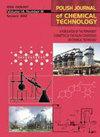A Comprehensive Analysis of the Hydrogen Generation Technology Through Electrochemical Water and Industrial Wastewater Electrolysis
IF 1
4区 工程技术
Q4 CHEMISTRY, APPLIED
引用次数: 0
Abstract
Most renewable energy sources are intermittent and seasonal, making energy storage and consumption problematic. Hydrogen gas can save and convey chemical energy, making it a promising sustainable energy source. Electrochemical water electrolysis technology’s sustainable and efficient hydrogen gas production attracts global attention. Higher hydrogen production rates enhance hydrogen volumetric energy capacity by storing intermittent hydrogen gas in high-pressure tanks. Pressurized storage tanks are cost-effective and efficient. Hydrogen gas may be stored economically and efficiently in pressurized tanks, making electrochemical water electrolysis a sustainable energy source. This paper introduced hydrogen as an alternative to natural gas, detailed water electrolysis technologies for hydrogen production, and highlighted how they can manufacture hydrogen efficiently and cost-effectively. The theoretical volume of gaseous hydrogen and oxygen that could be produced by electrolyzing water under typical temperature and pressure (STP) circumstances, assuming a 100% efficiency rate of the process. Since there are always two moles of hydrogen produced by electrolysis and one mole of gas occupies the same volume, the volume of hydrogen developed from water is twice that of oxygen. The volume of liberated oxygen is 0.21 (L/min), and the volume of liberated hydrogen is 0.42 (L/min) with a current density of 30 A, for instance, the tracer’s diffusion coefficient for all conceivable flow rates. A maximum value of 90 liters per hour was determined to be the threshold at which the diffusion coefficient increased with increasing flow rate. It would appear that the diffusion coefficient remains unchanged at flow rates greater than 90 liters per hour.电化学水和工业废水电解制氢技术综合分析
大多数可再生能源都是间歇性和季节性的,这使得能源储存和消耗成为问题。氢气可以储存和输送化学能,是一种前景广阔的可持续能源。电化学水电解技术可持续、高效地生产氢气,备受全球关注。通过将间歇性氢气储存在高压储罐中,提高氢气生产率,从而增强氢气的体积能量容量。加压储罐既经济又高效。氢气可以经济高效地储存在加压罐中,使电化学水电解成为一种可持续能源。本文介绍了氢气作为天然气替代品的情况,详细介绍了水电解制氢技术,并重点介绍了这些技术如何高效、经济地制造氢气。在典型的温度和压力(STP)条件下,假设该过程的效率为 100%,电解水可产生的气态氢和氧的理论体积。由于电解产生的氢气总是两摩尔,而一摩尔气体所占体积相同,因此从水中生成的氢气体积是氧气体积的两倍。在电流密度为 30 A 时,释放出的氧气体积为 0.21(升/分钟),释放出的氢气体积为 0.42(升/分钟)。最大值 90 升/小时被确定为扩散系数随流速增加而增大的临界值。在流速大于每小时 90 升时,扩散系数似乎保持不变。
本文章由计算机程序翻译,如有差异,请以英文原文为准。
求助全文
约1分钟内获得全文
求助全文
来源期刊

Polish Journal of Chemical Technology
CHEMISTRY, APPLIED-ENGINEERING, CHEMICAL
CiteScore
1.70
自引率
10.00%
发文量
22
审稿时长
4.5 months
期刊介绍:
Polish Journal of Chemical Technology is a peer-reviewed, international journal devoted to fundamental and applied chemistry, as well as chemical engineering and biotechnology research. It has a very broad scope but favors interdisciplinary research that bring chemical technology together with other disciplines. All authors receive very fast and comprehensive peer-review. Additionally, every published article is promoted to researchers working in the same field.
 求助内容:
求助内容: 应助结果提醒方式:
应助结果提醒方式:


